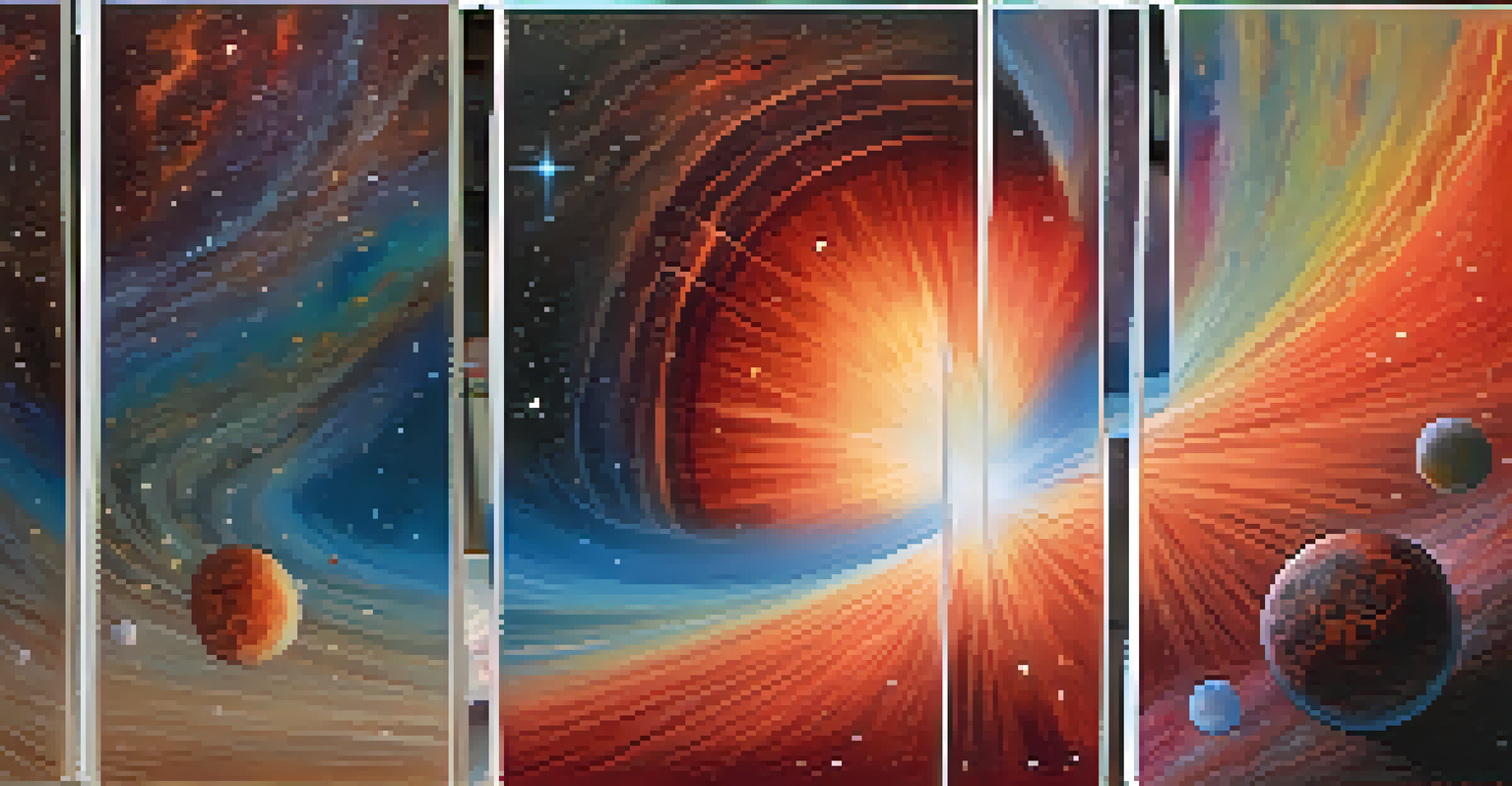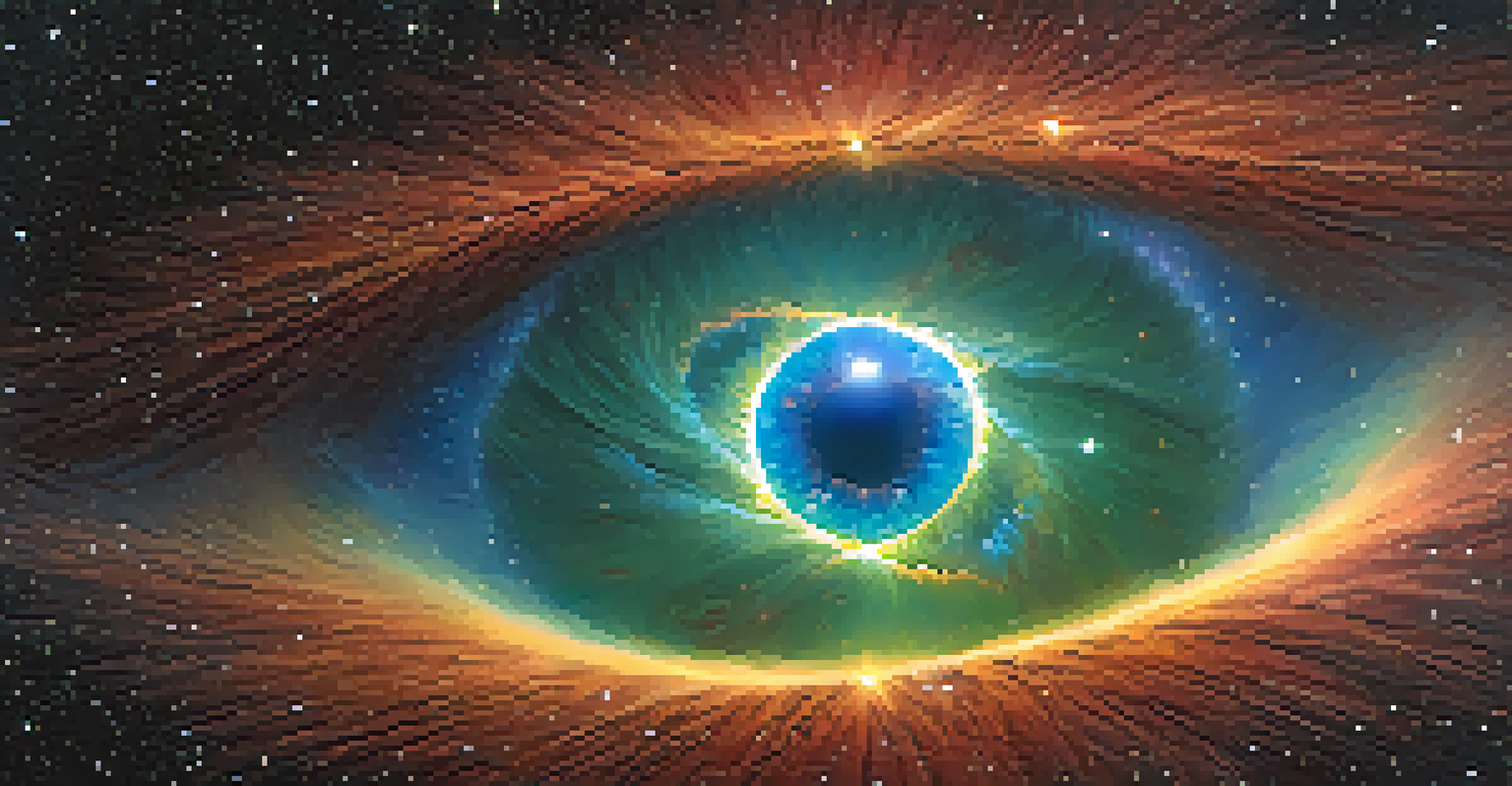Planetary Nebulae: The Final Stage of Stellar Evolution

What Are Planetary Nebulae and Their Importance?
Planetary nebulae are stunning celestial structures formed during the final stages of a star's life. Despite their name, they have nothing to do with planets; instead, they represent a phase where a star sheds its outer layers. This process creates a glowing shell of ionized gas that can be observed across vast distances in the universe.
The cosmos is within us. We are made of star-stuff. We are a way for the universe to know itself.
Understanding planetary nebulae is crucial for astronomers as they provide insights into stellar evolution and the lifecycle of matter in the cosmos. They act as a bridge between the life of a star and the formation of new stars, enriching the interstellar medium with essential elements. This recycling process is vital for the continuation of the cosmic cycle.
Moreover, studying these nebulae helps scientists learn more about the dynamics of star formation and the eventual fate of stars like our Sun. As we unravel the mysteries of planetary nebulae, we gain a deeper appreciation for the intricate dance of life and death in the universe.
The Life Cycle of Stars Leading to Planetary Nebulae
Stars go through several phases during their lifetimes, and planetary nebulae emerge at the end of this journey for medium-sized stars. Initially, a star spends the majority of its life in the main sequence phase, where it fuses hydrogen into helium. As the hydrogen supply dwindles, the star expands into a red giant, marking the beginning of the end.

During the red giant phase, the outer layers of the star become unstable and are eventually expelled into space, forming the beautiful nebula we see today. This shedding of material is not just a dramatic finale; it's a necessary step that allows the star's core to contract and heat up, eventually leading to the creation of a white dwarf. The beauty of this transformation is a testament to the cyclical nature of stellar life.
Planetary Nebulae and Stellar Evolution
Planetary nebulae are crucial for understanding stellar evolution and the recycling of elements in the universe.
In essence, the transition from a luminous star to a radiant planetary nebula is both a spectacular and humbling event. It serves as a reminder that even in death, stars contribute to the creation of new celestial bodies, continuing the cycle of life in the universe.
The Structure and Components of Planetary Nebulae
Planetary nebulae are composed of several fascinating components, primarily ionized gas and dust. When a star sheds its outer layers, the intense heat from the remaining core excites the ejected gas, causing it to glow. This glowing shell can showcase a variety of colors, primarily greens, blues, and reds, depending on the elements present.
For small creatures such as we, the vastness is bearable only through love.
The central star, now a white dwarf, is often surrounded by a complex structure of gas and dust. These shapes can vary widely—from spherical to more irregular forms—often influenced by the star's rotation and surrounding environment. This diversity in structure not only adds to their visual beauty but also provides clues about the star’s past.
Additionally, the chemical composition of planetary nebulae is rich in heavy elements, produced in the star's core during its lifetime. These elements, such as carbon and oxygen, are essential for the formation of new stars and planets, emphasizing the role of planetary nebulae in cosmic evolution.
Famous Examples of Planetary Nebulae
One of the most famous examples of a planetary nebula is the Ring Nebula (M57), located in the constellation Lyra. This nebula is easily recognizable due to its distinctive ring shape and has been a subject of fascination for astronomers for centuries. Its intricate structure and vibrant colors make it a popular target for both amateur and professional astronomers alike.
Another noteworthy example is the Helix Nebula (NGC 7293), often referred to as the 'Eye of God' due to its striking resemblance to a giant eye. Located in the constellation Aquarius, the Helix Nebula is one of the closest planetary nebulae to Earth, making it a prime candidate for detailed study. Its well-defined structure provides valuable insight into the processes that shape these cosmic wonders.
Diverse Structures and Components
These nebulae showcase a variety of colors and shapes, influenced by their central stars and surrounding environments.
Lastly, the Dumbbell Nebula (M27) is another stunning planetary nebula that showcases the beauty of stellar death. This nebula is notable for its bright central star and expansive cloud of gas, which can be seen even with small telescopes. Each of these examples illustrates the diversity and splendor of planetary nebulae, captivating the imagination of stargazers.
How Do Astronomers Study Planetary Nebulae?
Astronomers utilize a variety of advanced tools and techniques to study planetary nebulae, ranging from ground-based telescopes to sophisticated space observatories. These instruments allow scientists to observe the fine details of these nebulae, capturing their colors, shapes, and chemical compositions. This wealth of data is crucial for understanding the physical processes at play.
Spectroscopy is one of the key techniques used to analyze planetary nebulae. By examining the light emitted from these nebulae, astronomers can determine the elements present and their relative abundances. This information helps to piece together the history of the star that created the nebula and its role in the broader cosmic environment.
Additionally, computer simulations and models play a significant role in studying these celestial phenomena. By simulating the physical conditions of planetary nebulae, scientists can predict their evolution and understand the dynamics involved in their formation, leading to deeper insights into the lifecycle of stars.
The Role of Planetary Nebulae in Cosmic Recycling
Planetary nebulae play a vital role in the process of cosmic recycling, a term that describes how stars enrich the interstellar medium with heavier elements. When a star explodes in a supernova or sheds its outer layers, it releases these elements into space, creating the building blocks for new stars and planets. This cycle is essential for the ongoing evolution of the universe.
As the ejected material from planetary nebulae mixes with the surrounding gas and dust, it contributes to the formation of new star systems. The enriched interstellar medium provides the necessary ingredients for the next generation of stars, allowing for a continuous cycle of birth, life, and death in the cosmos. Without this recycling process, the universe would lack the diversity of elements needed for life as we know it.
Future Research Promises Insights
Advancements in technology, such as the James Webb Space Telescope, will enhance our understanding of planetary nebulae and their role in the cosmos.
Ultimately, the legacy of planetary nebulae extends far beyond their stunning visuals; they serve as crucial players in the vast cosmic tapestry. By understanding their role in cosmic recycling, we gain a deeper appreciation for the interconnectedness of all celestial bodies and the intricate processes that govern the universe.
The Future of Planetary Nebulae Research
As our technology advances, the future of planetary nebulae research looks promising. New telescopes, like the James Webb Space Telescope, are equipped with cutting-edge instruments that will allow astronomers to study these nebulae in unprecedented detail. This enhanced capability will undoubtedly lead to new discoveries and a better understanding of stellar evolution.
Moreover, ongoing research projects and collaborations among astronomers worldwide are set to expand our knowledge of planetary nebulae. By sharing data and findings, scientists can piece together the complex puzzle of how these celestial structures form and evolve over time. This collaborative approach fosters innovation and drives the field forward.

In conclusion, the study of planetary nebulae is not just about understanding the past but also about exploring the future of our universe. As we continue to unravel the mysteries of these cosmic wonders, we pave the way for new insights into the life cycles of stars and the processes that shape our cosmos.